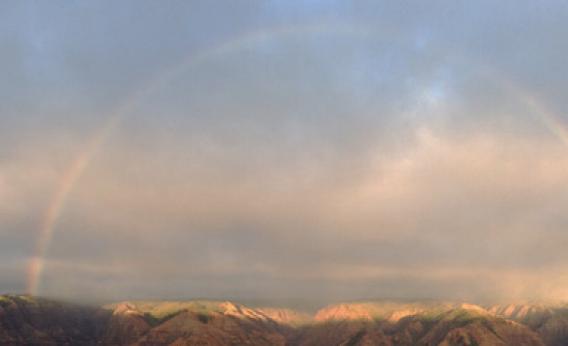Create a free profile to get unlimited access to exclusive videos, sweepstakes, and more!
A Hawaiian Sunset Rainbow

[Note from author: In the tradition of Boing Boing's "Unicorn Chaser"âposting a picture of adorably cute unicorns as a palate-cleanser after posting something nasty and disturbingâI've decided to write this article. My last post still has me fuming, and a rainbow does as well as a unicorn, I think.]
Rick Mann was in a hurry. He was vacationing in Kauaâi in Hawaii and wanted to get a good shot of the Waimea Canyon as the Sun set over it. As the canyon darkened, he set up his camera to take one picture per second, placed it on a makeshift stand, and then started it up. While it was shooting he wandered around for a few minutes, then went back to the camera and packed it up to head home.
When he got back and looked at the footage, what he got was magic:
That is cool. And of course, itâs not magic. Itâs SCIENCE.
Rainbows form when there are lots of raindrops in the air. Sunlight enters the drop and gets bent a little bit. It reflects off the back of the drop, then exits the drop, having had its direction changed: The sunlight gets bent by a total of about 138 degrees. What this means is that if you face directly away from the Sun (whatâs called the antisolar point), raindrops that are 42 degrees away from that direction (180 â 138 = 42) will bend the light just the right amount to send it back to you so you can see it (the fantastic website Atmospheric Optics has more diagrams of this).
If this were all there were to it, then if you faced directly away from the Sun youâd see a bright white light in the sky forming an arc 42 degrees away from the antisolar point. But of course thereâs more. Different colors get bent by different amounts! Blue light is bent slightly more than red, so in reality each color leaves the drop at a slightly different angle. The drops act as prisms, separating the colors.
So you get that big arc, but the colors are layered, each at a slightly different distance from the antisolar point. A rainbow! This page at Atmospheric Optics and this really good one at Polarization.com can help you visualize this.
You need direct sunlight for this to work, so rainbows commonly appear after it rains and the clouds start to break up. There are still drops in the air but there's also sunlight, too. In Boulder, where I live, we see them all the time following afternoon thunderstorms; the clouds blow east, the Sun is in the west, and we get brilliant rainbows in the east
In Mannâs video (as opposed to Boulder rainbows) the rainbow forms as the clouds blow over and the rain begins, since the wind is blowing to the west. You can also see the rainbow changes brightness due to the number of drops in the air. As the clouds blow over the canyon, the amount of rain is different in different spots, so in some places the rainbow is bright and in other places not so much.
But what struck me the most was how wide and tall the rainbow is! Since rainbows are opposite the Sun in the sky, if the Sun is high (like in the early afternoon) the rainbow is low to the horizon. If the Sun is low, the rainbow is high up. Mann took his pictures at sunset; the Sun was on the horizon, so the rainbow is high and nearly a perfect semicircle. For me itâs rare to see that because the mountains to my west block the Sun before it gets too low. My rainbows always look a little squatter than this one.
I like the video, too, because the rainbow fades in, getting stronger with time, and the clouds are flowing right toward and over the camera. I get a certain Stargate feel out of it. Indeed.
I love rainbowsâreally, who doesnât?âbecause they are a fascinating display of optics, of the interplay of light and water, and even how our eyes perceive light and color.
But also? Theyâre really pretty.
Tip oâ the polarizing filter to Chris Schoeneman for letting me know about this video.


























